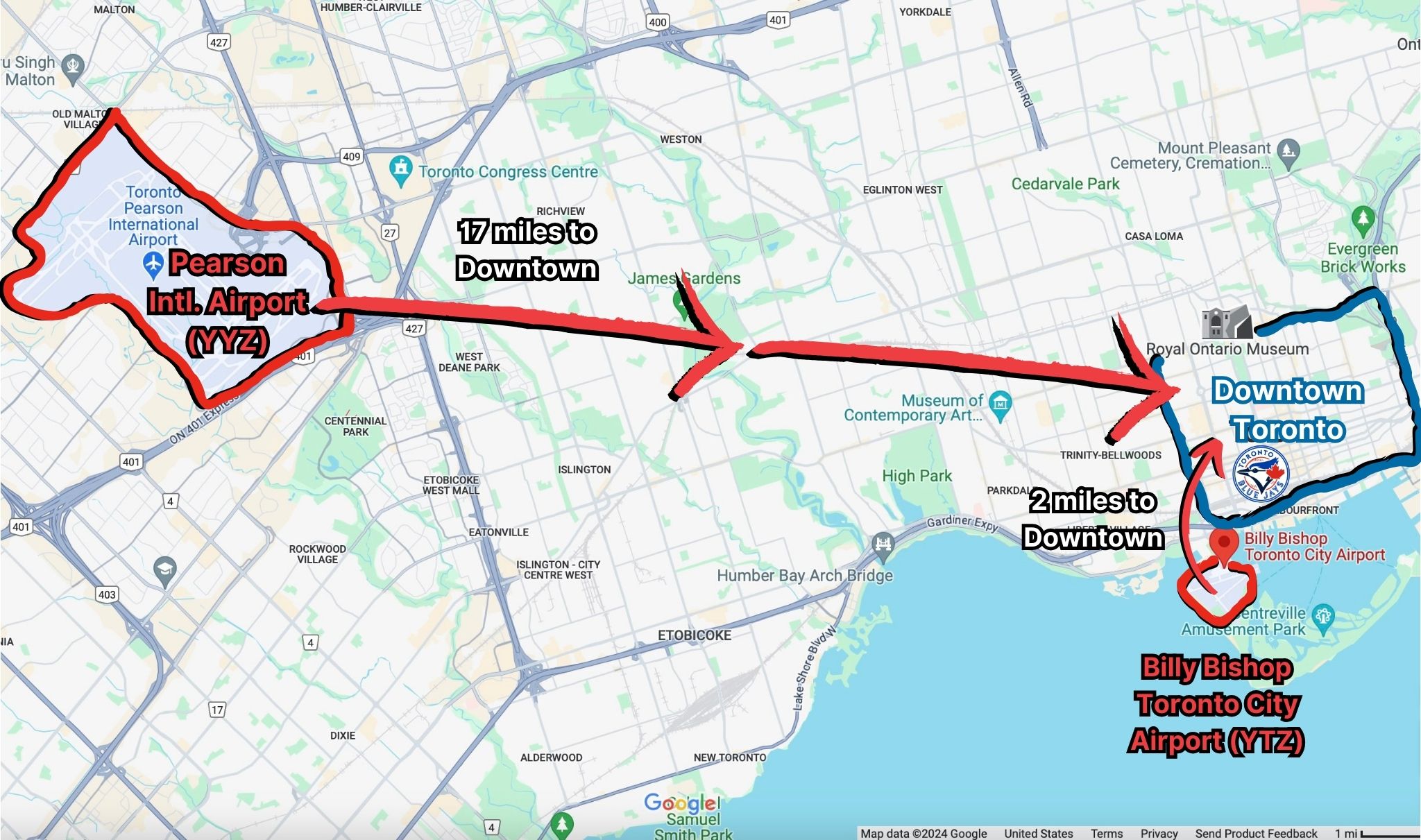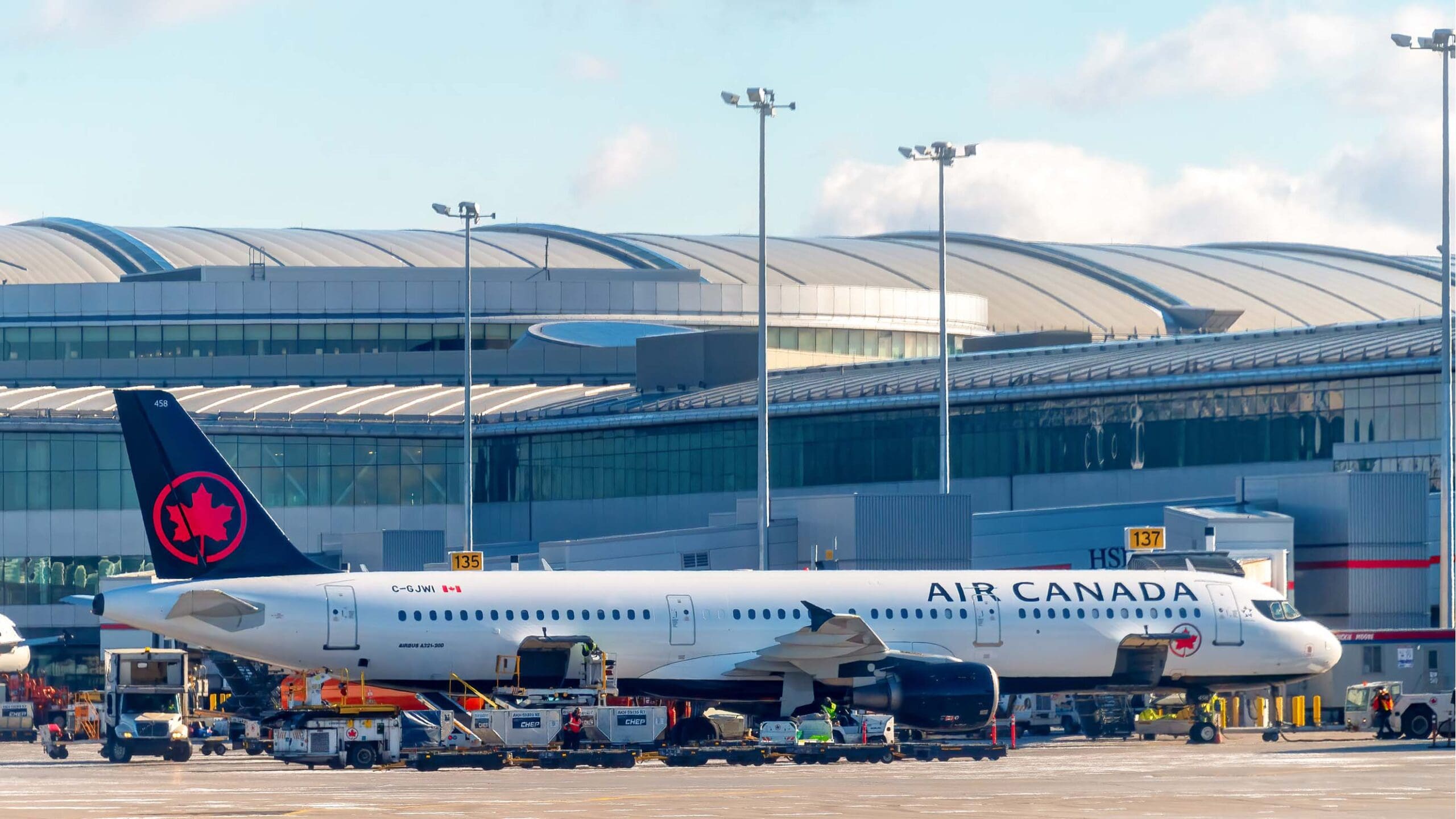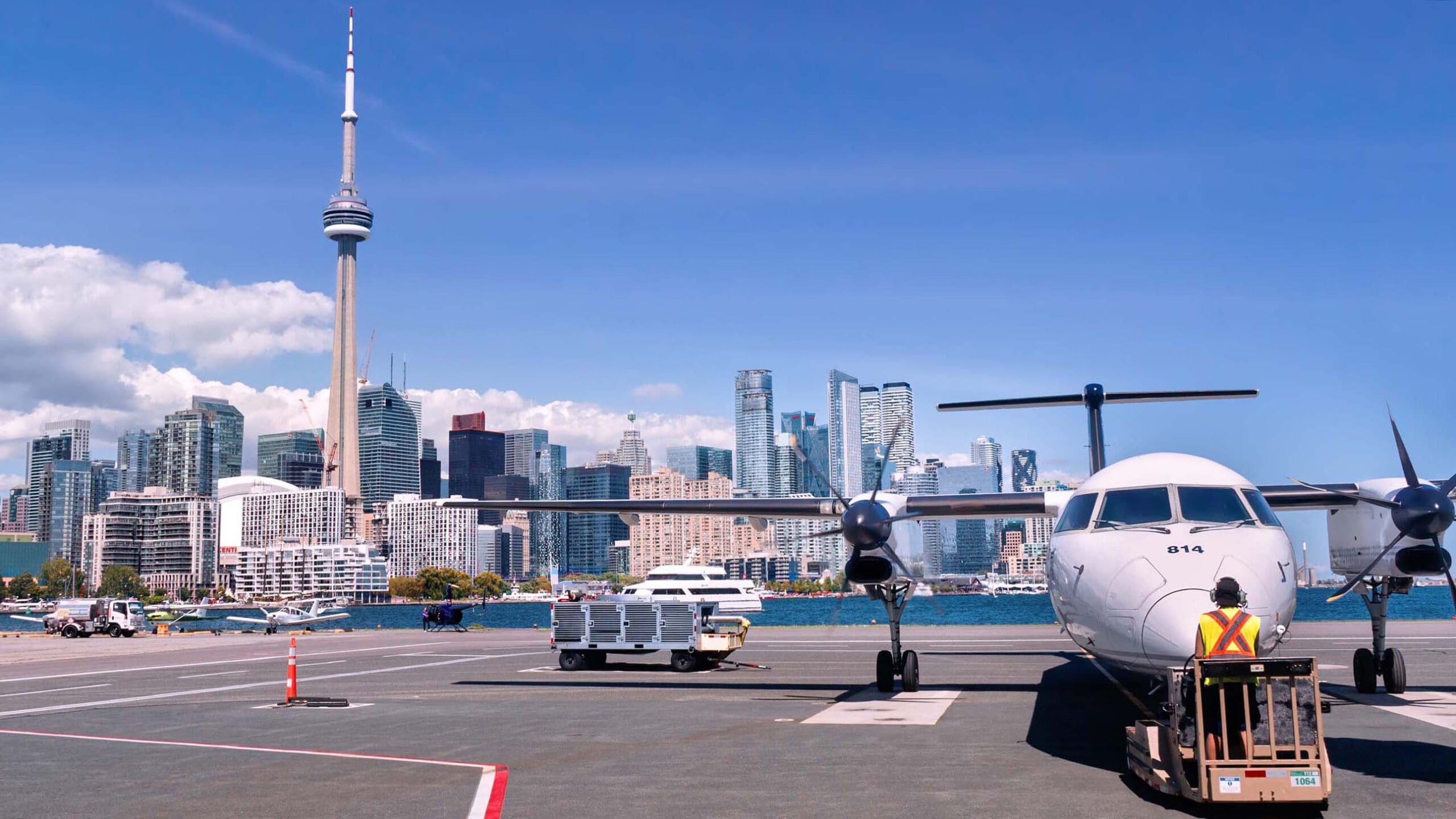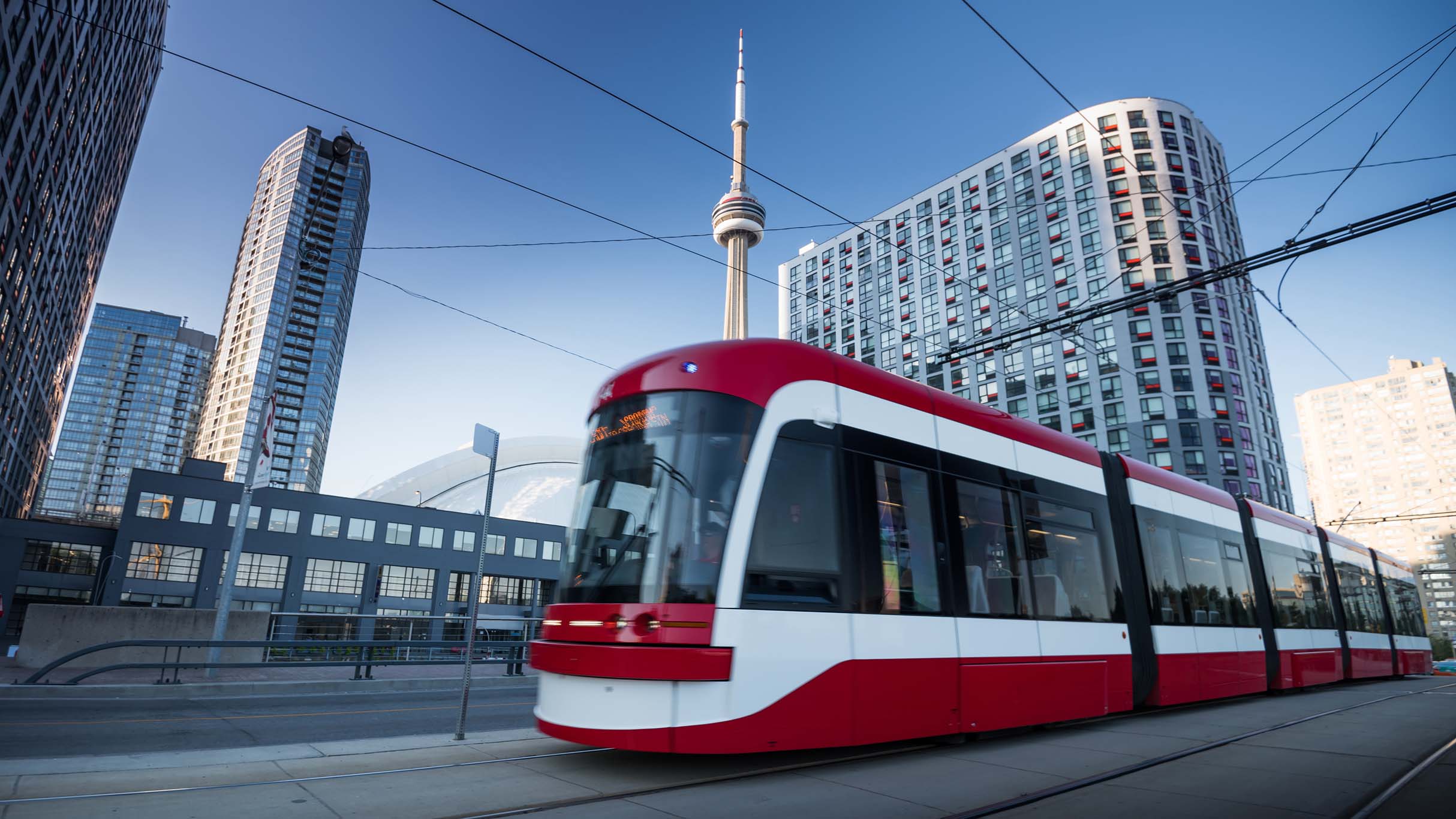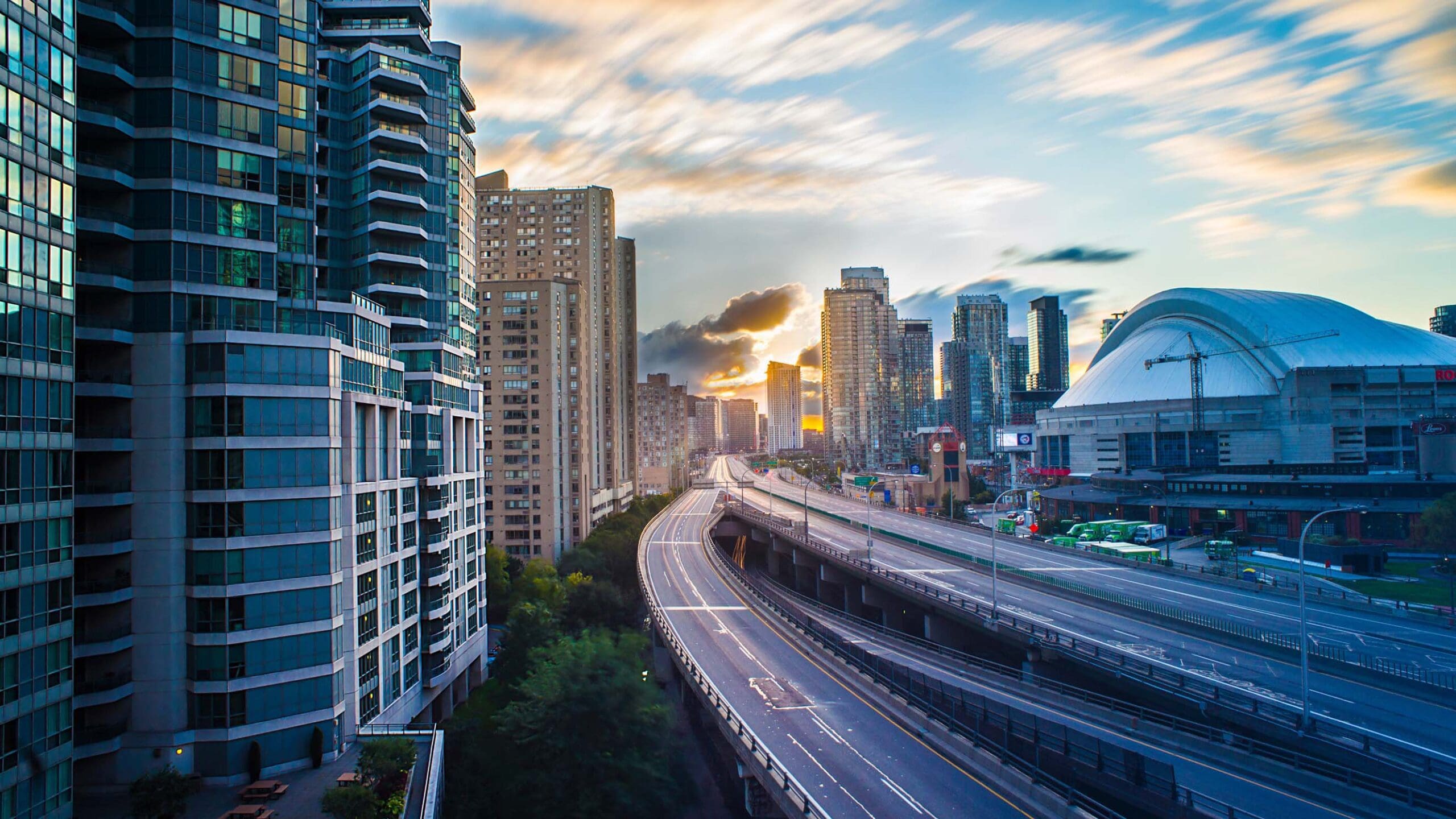Traveling to Toronto
When planning your trip to the Rogers Centre, you might have questions about how to get to Toronto, and what your ground transit strategy should be. We’ve got you covered with some helpful information. This chapter will provide guidance on traveling to Toronto, and getting from the airport to downtown.
Here’s what we’ll cover:
- Flying to Toronto
- Transportation from the airport to downtown
- Renting a car vs. public transportation
- Driving to Toronto
In our Local Transit chapter, we’ll outline how to get to and from the Rogers Centre from wherever you’re staying.
Flying to Toronto
If you’re planning on flying into Toronto, you may have a choice of two different airports for your arrival, depending on your departure city. The larger airport is Pearson International Airport (YYZ), which is located just outside the city limits, about a half-hour drive (without traffic) from downtown Toronto. Pearson International is a very large airport and serves as a major Canadian hub, so it is usually possible to get direct flights into Pearson from most major cities in the U.S. and Canada.
Toronto also has a smaller, regional airport – Billy Bishop Toronto City Airport (YTZ). Billy Bishop Airport is located on the Toronto Islands, directly south of the downtown core, and just one mile to the Rogers Centre. It is far less busy and much easier to navigate than Pearson International, so if it is an option for you, we recommend using this airport over the less-conveniently-located Pearson International.
But service into Billy Bishop is limited, with direct flights from about 15 Canadian cities, and four U.S. cities (Boston, Chicago Midway, Newark, and Washington Dulles). But if you’re coming from one of those cities, definitely be sure to check it out, because it is infinitely more convenient, and may also give you an opportunity to more easily catch a game on the same day that you arrive or leave.
Getting from Pearson International to Downtown
Upon arriving at Pearson, you will have a number of different options for getting downtown, including taxis, ridesharing apps, renting a car, or public transportation.
Ridesharing apps are typically less expensive than taxis, which have a set rate of $50-70 CDN for a trip from Pearson to Union Station, depending on your exact destination. You can expect an Uber or Lyft to cost around $25-$50 CDN to get you from Pearson to the downtown core, and the ride will usually take between 30-60 minutes, depending on traffic. Lyft can sometimes be slightly cheaper than Uber, but Uber has a much bigger in presence in Toronto, so expect longer wait times if you are using Lyft. (If you only have the Lyft app on your phone, we would suggest downloading Uber and setting up an account before getting to Toronto).
Perhaps the easiest way to get from Pearson to downtown Toronto is to utilize public transportation. The UP Express is a train system that takes you directly from the airport to Union Station, right in the heart of downtown Toronto. The trains depart the airport every 15 minutes, and the total trip time is only 25 minutes.
A one-way adult fare (ages 20-64) on the UP Express will cost $12.35 CAD. Group rates are also offered at $25.00 for three people, $32.50 for four people, and $40.00 for five people. You can also get a family pass, which is $25.70 and covers two adults and three children 13-19 years old (kids 12 and under ride for free, so factor that into how many fares you need to buy). The senior fare for anyone age 65+ is $6.20. For more information on fares, check out the UP Express website.
Essentially, the UP Express is cheaper, faster, and easier to navigate than ridesharing, taxis, or rental cars. It is also very safe. If you are comfortable using public transportation and are staying in or near downtown Toronto, we recommend taking advantage of the UP Express. If you’re going to opt for the train, it’s most convenient to stay in the area around Union Station. Our section on Lodging will discuss what hotels would be best for this.
Getting from Billy Bishop Airport to Downtown
The true beauty of this small regional airport lies in its location. There is virtually no commute to downtown Toronto, as you will be landing on an island just off the shore of downtown.
Because the airport is literally on an island, you either have to walk 5-10 minutes in a pedestrian underwater tunnel to get to the terminal, or you can take the 90-second free ferry that connects the terminal to the shore (yeah, it’s crazy that there’s a giant ferry that connects the two, but it’s essentially nothing more than a fancy terminal tram that you’d find in any other airport). But hey … it’s free, and it’s pretty scenic, so why not! There’s no tickets or anything like that – just walk on and walk off. It goes back and forth every 15 minutes (seven minutes each way), so there’s little waiting.
Once you’re on the mainland, you can either get a rideshare or taxi to your hotel, or take the free shuttle to Union Station that runs every 15 minutes. If you’re staying anywhere within quick walking distance of Union Station, that’s definitely what we’d recommend.
Renting a car vs. public transportation
You may be considering renting a car in Toronto instead of dealing with public transportation or ridesharing. If you plan to leave Toronto and visit neighboring cities or someplace like Niagara Falls, then renting a car may make sense for you. However, if you plan on staying in Toronto for your trip, we do not recommend renting a car.
First of all, renting a car means dealing with traffic, which is no picnic in Toronto. This city has a very large population and is very dense, so the traffic is always a nightmare during rush hour. In fact, the navigation and location technology company TomTom released its annual 2024 traffic report earlier this year and Toronto ranked as the worst city in North America in terms of traffic and congestion, edging out previous winners like New York and Mexico City.
Also, if you have a rental car, you will also have to deal with the hassle of parking. Parking in Toronto is extremely limited and is prohibitively expensive. Some parking lots in Toronto charge upwards of $20 CDN per hour. Your hotel will also charge you for parking, and the parking around the Rogers Centre is also expensive and hard to find. Sure, you may get lucky with a cheap public street parking spot once in a while, but it’s definitely a roll of the dice and the odds aren’t in your favor.
Finally, if you do rent a car, it will take you extra time to return it at the airport, and depending on where you’re flying to and what time your flight is, that could impact your ability to catch your plane after a 1:37pm Sunday game.
Toronto is also a very walkable city, and the public transportation network is usually very serviceable. There are a couple of major subway lines that can get you to most parts of the city quickly and cheaply, and a light-rail system that can get you most everywhere else. If the weather is nice, walking is always an option as well. There are plenty of restaurants, bars, and attractions within a 20-minute walk of Union Station in the center of downtown, including the Rogers Centre.
So, if it is possible for you to avoid renting a car, we highly recommend you skip the rental car line and save yourself the trouble and unnecessary cost.
Getting to Toronto by car
If you plan on driving to Toronto, please be sure to account for the horrible traffic as you approach the city. Traffic usually begins to build up just before 3pm and typically lasts until around 8pm on weekdays, and can go much later on Friday and Saturday nights. If you are driving in for an evening game, which typically starts at 7:07pm, you will want to give yourself plenty of breathing room to account for the traffic.
It is best to use a navigation app like Google Maps or Waze to get you to your hotel or the stadium. There are frequent road closures due to construction, and you will want to have live traffic updates to find you the best route. I find that Waze is slightly more accurate with the live traffic updates, but both will work fine.
Also, remember if you are driving from the U.S., you will need a passport to get across the border, and border crossing times can vary significantly and without warning.
Bottom Line
We strongly suggest you do not rent a car if you can avoid doing so, and instead use the public transportation system or walk when you can. If you must brave the traffic for whatever reason, it makes sense to use a ridesharing app instead of renting a car, because at least you will avoid the hassles of parking. If you are from a city which also has bad traffic and are thinking “how bad can the traffic in Toronto really be?” … don’t say we didn’t warn you.

